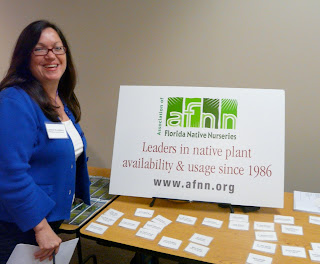Economics in the Native Plant Industry
 |
| Cammie Donaldson, Executive Director |
The group represented a mix of growers, retailers, landscape professionals, municipal reps, and Florida Native Plant Society (FNPS) members who spent the day in intense, active learning about current conditions influencing the commercial native plant sales industry today. Seven professors from the University of Florida gave excellent presentations and led stimulating discussions.
Dr. Alan Hodges, an economist intimately familiar with the native plant industry, said the good news is that the economy is growing again, albeit slowly and with a bit of bouncing. However, it seems possible to many that we are experiencing a fundamental change in the human condition. Because technology has replaced many jobs, we may never be able to return to the more favorable unemployment rates of pre-2008, even when the economy strengthens.
So what has happened to the horticultural industry since the disasters of 2008? Interestingly, his graph showed that sales from ‘greenhouse, nursery, and floriculture’ were down only slightly since 2008, although I noted that this was met with disbelief from those in the room. Sales from retail lawn and garden centers were way down, but sales in the landscape services sector are actually up since 2008. He explained that this mainly represented maintenance, not design and new landscaping services. It seems that many people do not have the time to do their own maintenance.
Of the total sales of plants in Florida, 19% were native plants. We lag behind some states like Nebraska and Minnesota where fewer non-natives can survive. We also lag behind Arizona where severely limited water supplies (and get ready, Florida) have forced people to go to native plants, and Texas.
There are two major trends that will affect all plant sales in the near future. First is the trend toward outdoor living:
- Homeowners are now viewing their inside and outside space as a whole.
- Backyards and patios now serve as playgrounds, living rooms, home offices and kitchens
- In keeping with the healthy living trend, consumers are seeking sustainable gardening principles.
- As a result, there is a shift to get plants off chemicals and on a healthier, holistic lifestyle.
 |
| Putting heads together |
AFNN is already onboard with the strategic alliances, of course, with the recent formation Florida Native Plant Partnership. Plans for the development of this alliance are in the formative stages but hold great promise.
Next we delved into the heart of the matter, how to improve the bottom line for the small to mid-sized growers. Several tools were provided, including a powerful one developed and supported by the U of Fl, available at no cost. But before he started in on these, Dr. Hodges cautioned the growers to remember one basic rule: “Just because you love a plant, doesn’t mean you have to grow it!” He reminded the audience that they could enjoy plants in their own ornamental gardens, but to make sure that the ones in the growing area were ones that were selling. He knew his audience.
Using as an example one woody plant taken from a liner (small pot), placed in a one-gallon container and grown out for one year, he listed all the associated costs. When you look at the costs that go into one such plant: plant itself, container, soil, fertilizer, chemicals, packaging, if sold away from nursery, watering, and pruning, it is quite an eye-opener. Plus you have add in what Dr. Hodges called the “rental rate,” the cost of the space the container took in the nursery. He provided formulas to help the growers figure in the direct and indirect costs, numbers to use for expected plant expiration in any one crop (about 5%) and how to include a number to plan for a profit.
Having accurate tools for basic inventory and bookkeeping, good managerial skills, and planning ahead, and frequent performance reviews are all imperative to success. As with so many other areas of life!!
This economic exercise had everyone eager for lunchtime, where spirited discussion continued.
Part 2 will cover the research on Ecotypes - plants with distinct and separate genetic composition
within a species resulting from adaptations to local environmental conditions. Hard questions were examined in relation to the importance and difficulty of obtaining plants suitable for true restoration.
sue dingwell



Comments
Sue says that invasives are coming up next.
Thanks,
Ginny
Any budding native nursery start-ups out there, we welcome you to this tough but rewarding (spiritually if not financially) industry.
Cammie Donaldson
Executive Director, Association of Florida Native Nurseries